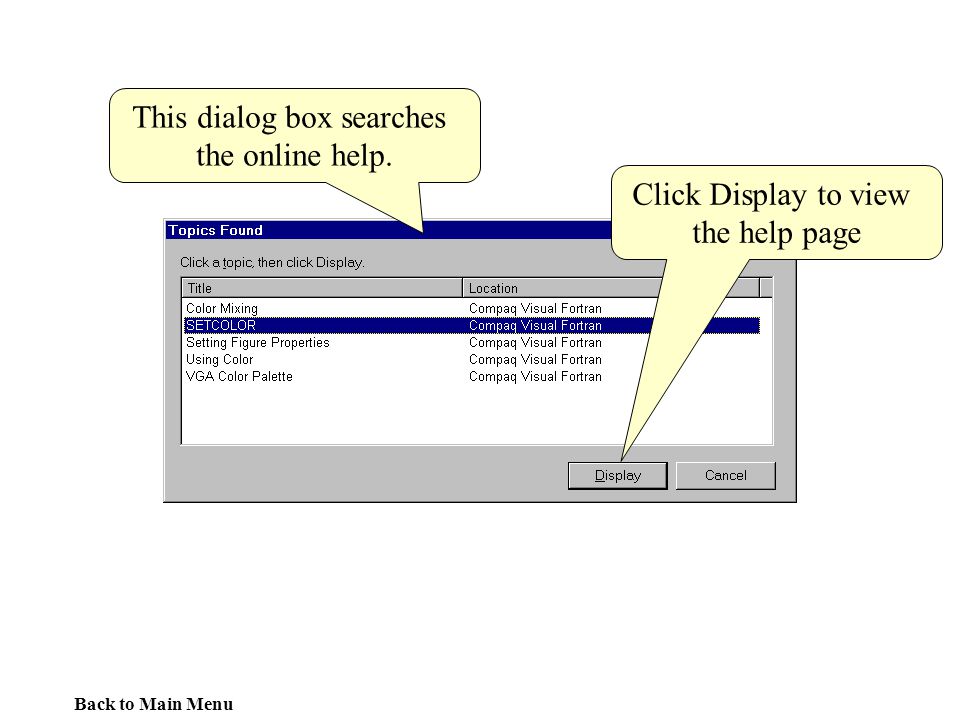
- #How to create a dialog in intel visual fortran install
- #How to create a dialog in intel visual fortran 64 Bit
- #How to create a dialog in intel visual fortran full
- #How to create a dialog in intel visual fortran code
- #How to create a dialog in intel visual fortran trial
Lahey/GNU Fortran.Ī new standard for Fortran programming from the leader in Fortran language systems.
#How to create a dialog in intel visual fortran trial
Trial versions for Windows are available. We think that once you work with a real Fortran development environment, you will never be able to go back to other minimal development environments.įull Fortran 77, 90, and 95 compliance with extensive support for the Fortran 20 standards.Ĭompatible with Visual Studio 2010/2012, Windows 8/7 (32 and 64-bit) and more.
#How to create a dialog in intel visual fortran full
Realize the full power of Visual Studio to dramatically improve productivity with Lahey’s Visual Studio Fortran support.
Lahey’s Exclusive Visual Studio Fortran support. #How to create a dialog in intel visual fortran install
Already have VS201x? Lahey’s LG Fortran will install into your existing Visual Studio without a hitch. LG Fortran comes with the most sophisticated development environment available – Visual Studio! The LGF compiler system will run in your choice of Visual Studio 2015, 2013 or 2012 development environments.
#How to create a dialog in intel visual fortran code
The Lahey Visual Studio Fortran development environment features a fresh build of GFortran, using the latest source code pulled from the stable branch of the repository, and the latest versions of the prerequisite packages.
#How to create a dialog in intel visual fortran 64 Bit
Automatic parallelizing compiler producing 32 and 64 bit executables. Dialogs don’t require the use of a windowing application if you are using the module IFLOGM. After you build and run the application (without changing the source files), the following dialog box appears: Dialog-based applications usually do not have menus.įor example, select the Dialog-based applications from the Fortran AppWizard screen. These applications call certain Intel Visual Fortran library routines and require the statement USE IFLOGM. Creating these applications requires some knowledge of the Windows routines API, but considerably less than for a SDI or MDI application. On using menus and dialogs from SDI and MDI Fortran Windowing applications, see Using Menus and Dialogs in SDI and MDI Fortran Windowing ApplicationsĪbout SDI and MDI Samples that use the Fortran Windowing project type, see Sample Fortran Windows Applications.ĭialog applications use a dialog box for the application's main window. If you selected the SDI option from the Fortran AppWizard screen and built and ran the application, you could not create child windows within the main window. IFWIN.F90 includes a Fortran version (a subset) of the Windows WINDOWS.H header file. If you want to limit the type of parameters and interfaces for Windows applications or if unresolved references occur when linking your Fortran Windowing application, see the Intel® Visual Fortran Compiler User and Reference Guides for information on calling Windows API routines.ĭata declarations for the WinMain function arguments.Īpplication-dependent code (other USE statements, variable declarations, and then executable code).įor example, consider the first lines of this sample, which uses free-form source code:INTEGER(DWORD) function WinMain (hInstance, hPrevInstance, & lpszCmdLine, nCmdShow)use IFWIN!DEC$ ATTRIBUTES STDCALL, DECORATE, ALIAS:”WinMain” :: WinMainINTEGER(HANDLE), INTENT(IN) :: hInstance, hPrevInstanceINTEGER(LPVOID), INTENT(IN) :: lpszCmdLineINTEGER(DWORD), INTENT(IN) :: nCmdShow. Any Fortran program or subprogram that references declarations from the Windows API must include a USE statement for either IFWIN, which collects all the available modules, or the appropriate subset modules for the Windows API libraries that are used. The Intel® Visual Fortran Compiler also provides individual modules for the various libraries that make up the Windows API, such as KERNE元2 and USER32. The USE IFWIN statement makes available declarations of constants, derived types and procedure interfaces for much of the Windows Application Programming Interface (API) routines, also referred to as the Windows API. The statement USE IFWIN or other appropriate USE statements In a program that includes a WinMain function, no program unit can be identified as the main program with the PROGRAM statement. 
The following function must be defined by the user:INTEGER(DWORD) function WinMain (hInstance, hPrevInstance, & lpszCmdLine, nCmdShow)use IFWIN!DEC$ ATTRIBUTES STDCALL, DECORATE, ALIAS:”WinMain” :: WinMainINTEGER(HANDLE), INTENT(IN) :: hInstance, hPrevInstanceINTEGER(LPVOID), INTENT(IN) :: lpszCmdLineINTEGER(DWORD), INTENT(IN) :: nCmdShow An interface block for the function declaration can be provided. The WinMain function declaration and interface are required for Windows Graphical User Interface (GUI) applications (typically use at least the GDI and USER32 Windows API routines). WinMain function declaration and interface


General Coding Requirements: WinMain Function and USE StatementsĬoding requirements for Fortran Windowing applications include (in the following order):







 0 kommentar(er)
0 kommentar(er)
